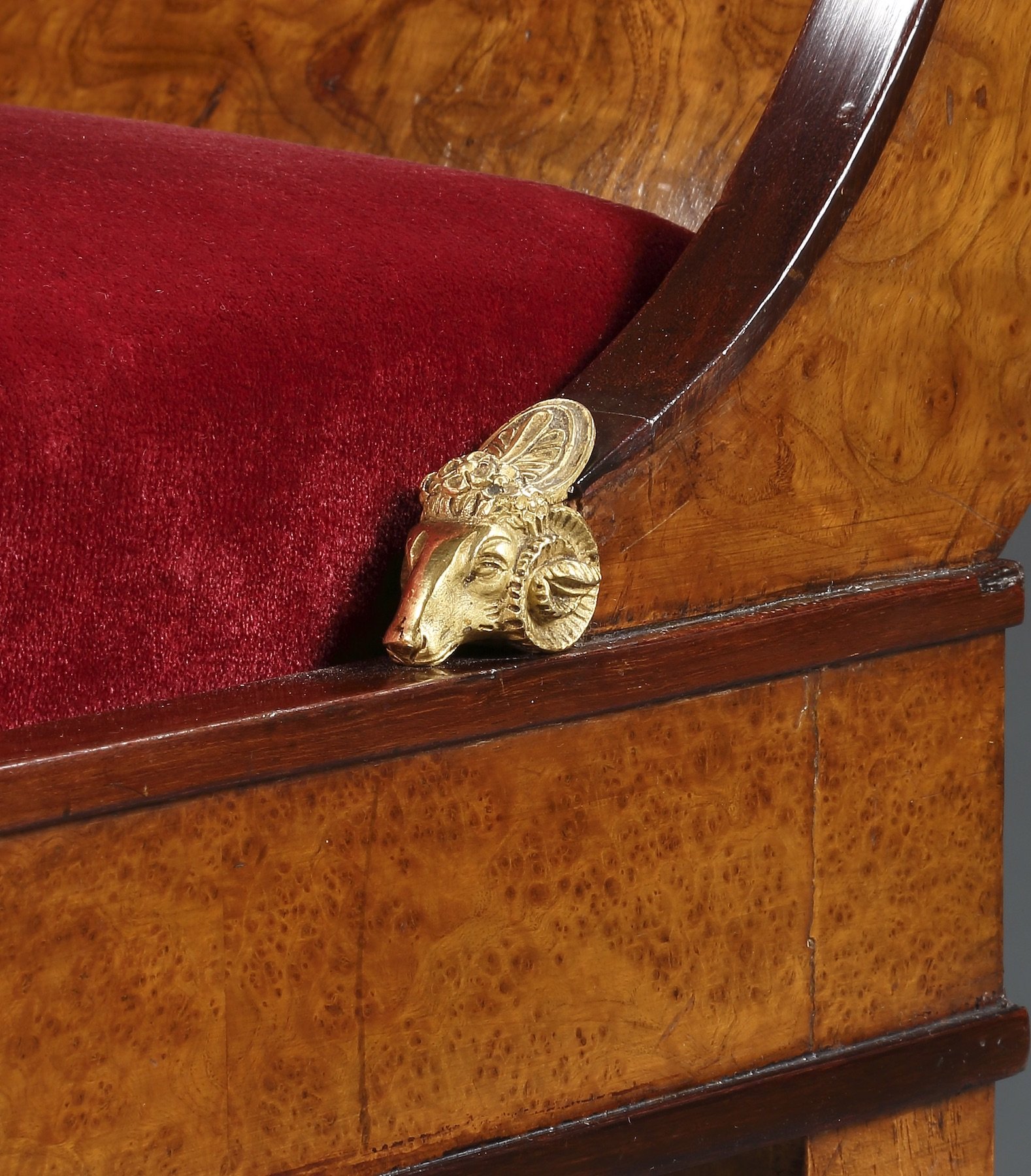Attributed to Joseph Marie Bénard
(French, ca. 1800–1825)
Set of Four Salon Chairs of Unusual Scale and Form in Contrasting Woods
Burr ash and amaranth with gilt-bronze mounts
32 x 18 ⅛ x 18 ⅛ inches (81.3 x 46 x 47 cm)
Bears handwritten circular paper label for the Millicent A. Rogers Collection: 33- / 5a.
Bears old printed and ink label: S/B Lot No. 84; Art. No. 50.
Of burr ash and amaranth with gilt-bronze mounts. Each with scrolling solid back with rams head gilt-bronze mounts above a plain frieze enclosed by square moldings. The front zoomorphic carved legs with carved lotus motif to the knees. The rear legs of saber form. One rams head mount replaced. Minor repairs to veneer.
Provenance:
Millicent Rogers (1902–1953), New York; by descent to:
Arturo Peralta Ramos Jr. (1928–2015), New York; his estate.
Exhibited:
“Chefs-d’Oeuvres des Grand Ébénistes 1790–1850,” Musée des Arts Décoratifs, Paris, January–February 1951, no. 21.
Literature:
Chefs-d’Oeuvres des Grand Ébénistes 1790–1850, Musée des Arts Décoratifs, Paris, January–February 1951, cat. no. 21.
This unusual set of salon chairs, in contrasting burl ash and amaranth, was attributed to the French ébéniste Joseph Marie Bénard (fl. 1818–1850) by the Musee des Arts Decoratifs in Paris. Bénard was established successively at 2 rue Saint-Paul in 1818, 6 rue Saint Avoge in 1820, 26 rue Neuve-Saint-Martin in 1822 and, finally, from 1828 at 57 rue Meslay in Paris. He was praised at the Exposition des Produits de l’Industrie in 1823 for his richly decorated furniture in indigenous woods, “the details of which are treated with the greatest care.”[i]
The chairs formed part of the collection of American heiress, collector, and jewelry designer, Millicent Rogers (Fig. 1).[ii] One salon chair of this set was almost certainly included in the 1951 Musée des Arts Décoratifs’ exhibition Chefs-d’Oeuvres des Grand Ébénistes 1790–1850. The salon chair was exhibited and published en suite with a fauteuil-gondole and which also formed part of Rogers’ collection, documented in situ at her home in Virginia, Cleremont Manor in the 1940s.
It is interesting to note that two other items, also attributed to Joseph-Marie Benard, were owned by Rogers. One is a lit en bateau, thought to have belonged to the Polish noblewoman Countess Walewska, mistress of Emperor Napoleon I. The other is an impressive cabinet, also of burl ash, which, interestingly bears an identical label to the chairs (S/B Lot No. 84).
The present chairs descended to Rogers’ son Arturo Peralta-Ramos Jr. and belonged to his home at 760 Park Avenue.
Fig. 1. Millicent Rogers photographed in her home in New York City for Vogue Magazine in 1945.
Detail image of the gilt rams head.
Second detail image of the gilt rams head.
[i] Héricart de Thury, Vicomte Louis-Étienne-François. Rapport Du Jury D’admission Des Produits De L’industrie Du Département De La Seine á L’exposition Du Louvre En 1823, Paris, 1825. 167.
[ii] Millicent Rogers was the daughter of Henry Huddlestone Rogers, a magnate of Standard Oil, and she grew up between Manhattan, Southampton and Tuxedo Park, New York. She contracted rheumatic fever as a child and suffered poor health for the remainder of her life, however, this would not deter her from cultivating a life full of culture, style and artistic talent. She spoke seven languages, designed jewelry and oversaw the collection and decoration of her many homes and apartments. The Italian fashion designer Elsa Schiaparelli said of her friend, “if she had not been so rich, with her incredible talent and her boundless generosity she would have become a great artist.” Rogers “was a fashion icon and socialite during the early decades of the 20th century and later became an activist promoting Native American rights,”[ii] and establishing a museum of Native American art in Taos, New Mexico, where she spent the end of her life. In addition to her home in Taos, which she named Turtle Walk, Rogers also had a townhouse on East 68th Street in New York City and the aforementioned estate on James River in Virginia called Claremont Manor which she owned between 1940–1950. Rogers married three times during the course of her life. In 1924 she eloped with her first husband, the Austrian count and professional tennis player Ludwig von Salm-Hoogstraeten, with whom she had a son, Peter Salm (however, the couple separated before he was born). They divorced in 1927 and in that same year Rogers married Arturo Peralta-Ramos, a wealthy businessman from an old and distinguished Argentine family. The couple had two children, Arturo Jr. and Paul, and divorced in 1935. Rogers’ last husband was American stockbroker Ronald Balcom (m. 1936 – div. 1941). See: Chiara Caputo, “Millicent Rogers: una vita alla ricerca della bellezza,” 23 January 2016. https://www.snobnonpertutti
.it/themode/millicent-rogers-una-vita-alla-ricerca-della-bellezza/14893; and “Claremont Manor.” North American Country Estates, 10 September 2021. https://americancountryestate.com/2021/09/10/claremont-manor/.




